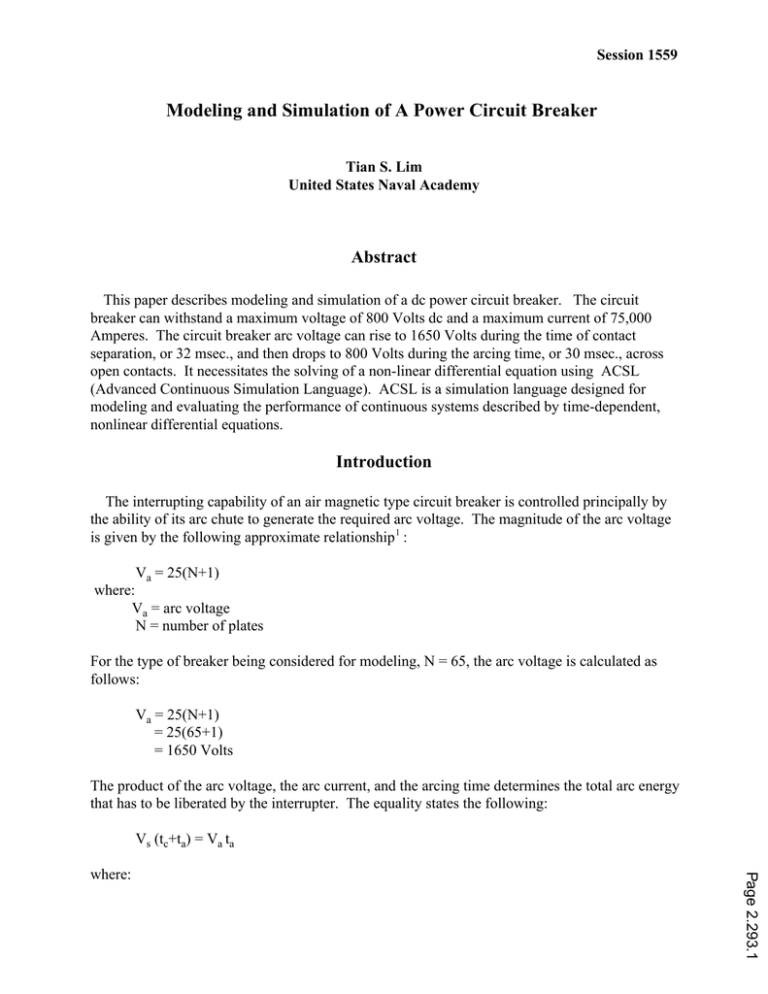Modeling And Simulation Of A Power Circuit Breaker
advertisement

Session 1559 Modeling and Simulation of A Power Circuit Breaker Tian S. Lim United States Naval Academy Abstract This paper describes modeling and simulation of a dc power circuit breaker. The circuit breaker can withstand a maximum voltage of 800 Volts dc and a maximum current of 75,000 Amperes. The circuit breaker arc voltage can rise to 1650 Volts during the time of contact separation, or 32 msec., and then drops to 800 Volts during the arcing time, or 30 msec., across open contacts. It necessitates the solving of a non-linear differential equation using ACSL (Advanced Continuous Simulation Language). ACSL is a simulation language designed for modeling and evaluating the performance of continuous systems described by time-dependent, nonlinear differential equations. Introduction The interrupting capability of an air magnetic type circuit breaker is controlled principally by the ability of its arc chute to generate the required arc voltage. The magnitude of the arc voltage is given by the following approximate relationship 1 : Va = 25(N+1) where: Va = arc voltage N = number of plates For the type of breaker being considered for modeling, N = 65, the arc voltage is calculated as follows: Va = 25(N+1) = 25(65+1) = 1650 Volts The product of the arc voltage, the arc current, and the arcing time determines the total arc energy that has to be liberated by the interrupter. The equality states the following: Vs (tc+ta) = Va ta Page 2.293.1 where: Vs = system driving voltage Va = arc voltage tc = time from fault initiation to contact separation ta = arcing time across open contacts The desired contact opening time for this breaker is 32 msec. Therefore, the expected arcing time is ta = Vs tc / (Va - Vs) = (800)(0.032)/(1650-800) = 30 msec. In summary, the arc voltage will rise to 1650 Volts during the time of contact separation, or 32 msec., and then drops to system’s driving voltage (maximum 800 Volts) during the arcing time, or 30 msec., across open contacts. The Model Figure 1 shows an R-L power network with a circuit breaker represented by cb where cb, as a circuit element, behaves like a non-linear resistor. The basic non-linear differential equation that describes the voltage-current relationship is E = Ldi/dt + Ri +Vcb (1) where Vcb is the arc voltage across the circuit breaker and therefore can be expressed as: Vcb = cb*i (2) The expression for di/dt, or rate of change of current with time, is di/dt = [(E - Ri) - Vcb]/L (3) Initially, E - Ri must be equal to zero since V cb = 0 and the inductor acts like a short circuit. Therefore, the di/dt at t = 0 must have a negative value equal to the arc voltage divided by the inductance L, indicating that the current initially decreases. If, however, the E - Ri term at some point is equal to the arc voltage, the di/dt is equal to zero and the current ceases to decrease. The basic criterion for arc interruption, therefore, is that the arc voltage term must continue to exceed the E - Ri term so that the current continues to decrease. This requires that at some time, the arc voltage exceed the system driving voltage. This can occur because the arc voltage is not a function of system voltage, but is instead determined by the arc characteristics. Based on equations (1), (2), and (3), and the arc voltage characteristics, the following ACSL 2 program was prepared and implemented: Page 2.293.2 PROGRAM power circuit breaker model !----Define program constants constant E=800, R=0.001067, R0=0.00009 constant xic=0, L=0.000135 constant tau1=0.006, tau2=0.0047 !----Circuit breaker model DERIVATIVE IF (T .GT. 0.032) THEN cb=800/i + (850/i)*exp ((0,032-t)/tau2) ELSE cb=R0*exp(t/tau1) END IF y=cb*i !----Integrate state variables di/dt=(E-R*i-cb*i)/L i=INTEG(di/dt, xic) !----Program termination condition END of Derivative constant Tstop=0.064 TERMT(T .GT. Tstop) END The result of the simulation is depicted in Figure 2. It shows that the breaker arc voltage rises from zero to 1650 Volts in 32 msec. and then drops to 800 Volts in 30 msec. across open contacts. Conclusion In recent years, computer simulation of electrical systems has become an important analysis tool used in the evaluation of hardware design prior to actual construction. In this paper, ACSL was used to model and simulate a type of dc power circuit breaker, plotting the behavior of the model under several external forcing functions, such as breaker current, breaker voltage, and the breaker impedance. A non-linear differential equation was written to describe the circuit breaker. The ACSL program provided a simple method of representing these mathematical equations on a digital computer. As runtime commands were written interactively to exercise the model, results were obtained for the model with varying constants. References Page 2.293.3 [1] ACB 4001R Circuit Breaker Arc Chute Design and Contact Structure Modifications, SPD Technologies, Philadelphia, PA 19116. [2] Advanced Continuous Simulation Language (ACSL) Reference Manual, Mitchell & Gauthier Associates (MGA) Inc., Concord, MA 01742. TIAN S. LIM Dr. Tian S. Lim is a professor of electrical engineering at the United States Naval Academy. He received D.Sc. degree in electrical engineering from the George Washington University. Figure 1. A dc power circuit breaker Page 2.293.4 Figure 2. Breaker arc voltage Page 2.293.5



